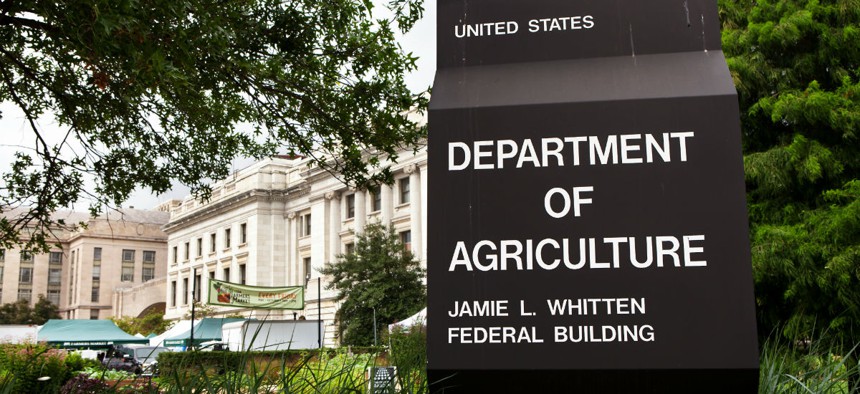
Mark Van Scyoc/Shutterstock.com
Agriculture Clamps Down On Telework, Stirring Union Resistance
Critics question the policy’s legality.
Nearly eight years after President Obama signed the 2010 Telework Enhancement Act, several agencies under the Trump administration are cutting back on telecommuting, creating uncertainty for employees and adding to traffic congestion in Washington.
At least two employee unions are crying foul, and employee surveys show the change is not popular.
The most dramatic cutback unfolded in January when the Agriculture Department issued a new policy that, while continuing to permit regulated telecommuting, asserted that the privilege “must be balanced to ensure there are no negative impacts on the ability of the department to achieve its mission and provide high-quality customer service.”
It reduced the permitted teleworking days from four days a week to one, or two per pay period.
The policy, planned just as collective bargaining talks had begun in December, is more restrictive than the old USDA policy, which had described telecommuting as “a method of reducing air pollution, reducing congestion, conserving energy, increasing employee productivity and efficiency, and retaining a creative, experienced, and diverse workforce,” albeit with formalized routine agreements.
Though similar curbs are underway at the Commerce and Education departments, Agriculture’s was linked expressly to Secretary Sonny Purdue’s pursuit of efficiency under the theme of “One USDA.” In his Jan. 3 New Year’s video statement, Purdue said, “From today forward, you will hear all of USDA leadership, from the Office of the Secretary on down, begin to refer to us as OneUSDA. Not as [Animal and Plant Health Inspection Service] or as the Forest Service, not as Rural Development or as [Foreign Agricultural Service, and not as distinct agencies sitting in the same office.”
In a statement to Government Executive on Monday, a department spokesman was more specific: “USDA’s telework policy is designed to be responsible to the taxpayers and responsive to the customers who depend on our services. It is also respectful of our fellow employees who come to work each day. This is just one part of Secretary Perdue’s OneUSDA philosophy, which promotes USDA as one family, working together as a single team to serve the American people.”
As reported on Monday by the Washington Post, the new policy was implemented without a traffic impact study, an omission faulted by the American Automobile Association. It projected that the withdrawn telecommuting agreements could add almost 42,000 weekly trips by road, trains, or buses. That could mean up to 2.1 million additional commuter trips yearly by the 5,200 USDA telecommuters in the Washington headquarters area. (About one-third of the department’s 97,000 nationwide employees telecommute, according to the Post.)
Rep. Gerry Connolly, D-Va., a major force behind the 2010 act, told Government Executive on Monday that his district has “the highest concentration of federal workers in the country. This is yet another move by the Trump administration that harms federal employees at no benefit to citizens. It will hinder the efficiency of our 21st-century workforce. Instead of instituting backward-looking policies like this one, we should be searching for ways to make federal government a more efficient and supportive place to work.”
A unit of the National Federation of Federal Employees, the Forest Service Council, in January did a survey of employees that has so far produced 3,300 replies. As many as 79 percent disagreed with the statement that “teleworkers in my work unit make it hard for me to accomplish my work or have a negative impact on service to our customers (internal and external),” the survey showed. Only 9 percent agreed. As many as 66 percent agreed that teleworkers are more productive because they have fewer distractions, while 11 percent disagreed.
“Rumors and legends have it that the agriculture secretary was having problems getting a couple of teleworking executives into the office for meetings,” Randy Meyer, a Forest Service genetics laboratory technician who is president and chief steward of his Forest Service Council in northern California, told Government Executive. Purdue is said to have “walked into a USDA office late one week and found nobody around. In November and December, people take big chunks of annual leave,” Meyer noted.
Meyer and other union representatives point out that collective bargaining talks were underway beginning last November when the policy was being prepared. “One caveat was that in the event that the agency negotiated an agreement, it required you to negotiate” the cutbacks on telecommuting. “The agency made the decision for all the non-NFEE bargaining unit employees,” Meyer said, but those in the bargaining unit remain under the old teleworking agreement. “So we currently have a two-tiered look” at the still-evolving situation.
Jeffrey Streiffer, who represents 210 employees in the Local 1106 of the American Federation of Government Employees in Agriculture’s Office of the General Counsel, called the narrowed telework options “a sea change in how management’s philosophy is going to proceed.”
He said AFGE has concerns about whether the policy change was properly reviewed by the Office of Personnel Management, as required under the telework act. The policy’s substance may also run counter to the act, he said.“We also have concerns that under federal labor relations law, the unions with a certain level of penetration have national consultation rights.” That means, Streiffer said, “that when the department changes working conditions, it has to provide national unions with a chance to review the proposed changes and comment.”
When management proposed the changes at the end of November, “we commented, saying they were unwarranted and unsubstantiated,” he said.
Management’s response was “we disagree,” and so “the final policy was even more restrictive than the policy floated under the national consultation process,” Streiffer added. Morale in general is down, he said, citing a recent survey. “People are looking for a way out.”
Image via Mark Van Scyoc/Shutterstock.com.







